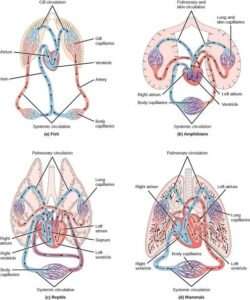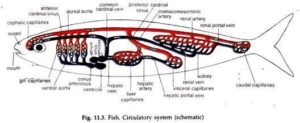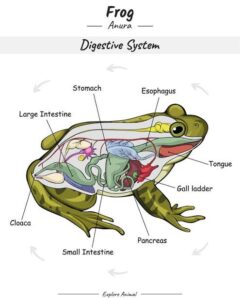Back to: ZOOLOGY 300 Level
WELCOME TO CLASS!
I’m thrilled to have you back—your dedication continues to shine! Today, we’re going to understand how two vital systems—the digestive and circulatory systems—have changed as animals evolved from fish to amphibians.
Think about a catfish in the River Niger, gulping food from the muddy floor. Now picture a frog catching flies with its sticky tongue in a garden in Ibadan. They both need to digest food and transport nutrients and oxygen, but their internal systems have unique differences and remarkable similarities. Let’s learn how evolution fine-tuned these systems for aquatic and land-based life.
Digestive And Circulatory Systems (From Fish To Amphibians)
Digestive System: From Fish to Amphibians
The digestive system helps animals break down food into smaller nutrients for energy and growth. Though both fish and amphibians are vertebrates, their digestive systems show key adaptations due to differences in diet and habitat.

In Fish:
- Fish have a straight or slightly coiled alimentary canal.
- The mouth often has sharp or specialised teeth depending on diet (e.g., tilapia vs. barracuda).
- Food passes into the pharynx, oesophagus, and then the stomach, where digestion begins.
- Enzymes from the liver, pancreas, and intestinal walls assist in breaking food down in the intestine.
- Most fish have a short digestive tract, especially carnivorous ones.
In Amphibians (e.g., frogs):
- Amphibians often have a longer digestive tract than fish, especially herbivorous or omnivorous species.
- The tongue is muscular and sticky, specially adapted for catching insects—especially in frogs.
- Amphibians have a well-developed stomach and small intestine where digestion and nutrient absorption take place.
- The cloaca is a common opening for waste, reproduction, and excretion—a feature shared with fish.
Key Transition:
As amphibians moved to land, their diets diversified (insects, worms, plants), and so their digestive systems became more flexible and efficient in handling different types of food.
Circulatory System: From Fish to Amphibians
This system moves blood through the body, delivering oxygen and nutrients while removing waste.
In Fish (Single Circulation):
- Fish have a 2-chambered heart (1 atrium and 1 ventricle).
- Blood flows in a single loop: heart → gills → body → heart.
- After picking up oxygen from the gills, the blood travels around the body before returning to the heart.
- This system works well in water, where oxygen is absorbed through gills.

In Amphibians (Double Circulation):
- Amphibians have a 3-chambered heart (2 atria and 1 ventricle).
- Blood flows in two loops:
- Pulmonary loop: heart → lungs/skin → heart
- Systemic loop: heart → body → heart
- This allows separation (though incomplete) of oxygenated and deoxygenated blood.
- Amphibians use lungs and skin for respiration, so their circulatory system had to adapt to handle oxygen from both sources.

Key Transition:
The move to land demanded a more efficient system for delivering oxygen. The 3-chambered heart allowed better oxygen distribution compared to the single-loop system in fish.
Summary
- Fish have simple digestive systems suited for aquatic feeding, while amphibians evolved longer guts and sticky tongues for catching land prey.
- The fish heart has two chambers and a single circulation loop, while amphibians have three chambers with partial separation of oxygen-rich and oxygen-poor blood.
- These changes reflect adaptations from aquatic to semi-terrestrial living.
Evaluation
- What are the key differences in the heart structure between fish and amphibians?
- Why do amphibians have a longer digestive tract than most fish?
- Explain the advantage of a double circulation system in amphibians.
- Describe how amphibians’ tongues differ from those of fish.
- What is the function of the cloaca in amphibians?
You’ve just unpacked how evolution shaped two of the most important systems in the animal body. Keep this energy going—every lesson is shaping you into a zoologist who understands not just animals, but the story behind how life works. See you in the next class!
